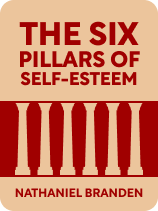

This article is an excerpt from the Shortform book guide to "The Six Pillars of Self-Esteem" by Nathaniel Branden. Shortform has the world's best summaries and analyses of books you should be reading.
Like this article? Sign up for a free trial here .
What’s Nathaniel Branden’s The Six Pillars of Self-Esteem about? What’s the key message to take away from the book?
In The Six Pillars of Self-Esteem, psychotherapist Nathaniel Branden presents a roadmap for improving your self-esteem. You’ll learn exactly how to behave to improve your self-esteem, including by living with awareness and taking responsibility for your actions. You’ll also learn why so many techniques people recommend for raising self-esteem just don’t work. Along the way, you’ll discover what self-esteem actually is, why it matters, and how others affect it.
Below is a brief overview of The Six Pillars of Self-Esteem by Nathaniel Branden.
Part 1: What Self-Esteem Is & Why It Matters
In his book The Six Pillars of Self-Esteem, Nathaniel Branden asserts that self-esteem is the foundation of psychological health. In order to improve your self-esteem, you must first understand what self-esteem is and why it matters. In this section, we’ll discuss the two essential elements of self-esteem and how your choices affect your self-esteem. Then, you’ll learn the four major reasons self-esteem matters, according to Branden.
What Self-Esteem Is
Branden argues that self-esteem comprises capability and worthiness. Capability, which Branden calls “self-efficacy,” is when you trust your own mind and judgment—so you feel like you’re generally capable of learning the skills you need to earn a living, have healthy relationships, and recover when you face difficulties. Worthiness, which Branden calls “self-respect,” is the belief that you deserve happiness because you’re inherently valuable: It drives you to treat yourself well and expect similar respect from others. Both beliefs are essential to self-esteem.
(Shortform note: Branden’s definition of self-esteem is unique: Most psychologists define self-esteem as your sense of global self-worth, or how much value you believe you have—which encompasses self-respect but not self-efficacy. Moreover, some psychologists argue that self-efficacy refers to your confidence to succeed in a specific task, and your confidence in your general capability is simply “confidence.”)
Branden contends that your self-esteem both drives and depends on your behavior in a never-ending cycle: Your actions align with your expectations of yourself, and your behaviors inevitably affect your self-esteem—you can’t avoid feeling some way about how you choose to behave, and these feelings affect your opinion of yourself.
(Shortform note: In Awaken the Giant Within, life coach Tony Robbins contends that your identity works similarly: Your identity is a set of beliefs about yourself, and since you strive to be consistent with your beliefs, you act in ways that reinforce your existing identity. However, Robbins attributes this striving for consistency to external societal pressure: Society says changing your beliefs is wishy-washy, so you avoid it.)
Why Self-Esteem Matters
1. Self-esteem affects you no matter what. As Branden notes, you can ignore your opinion of yourself, but you cannot refrain from having one. (Shortform note: It’s possible that the lower your self-esteem, the harder it is to ignore your opinion of yourself. In The Happiness Hypothesis, psychologist Jonathan Haidt explains that humans have a negativity bias that wires us to fear bad things more than we like good things—which may lead us to pay greater attention to negative thoughts.)
2. Self-esteem promotes your well-being. You’re capable of knowing what to do and choosing not to do it—but with high self-esteem, you select choices that support your well-being instead. (Shortform note: In reality, most of us don’t make the best choices available, regardless of our self-esteem levels. As psychologist Daniel Kahneman explains in Thinking, Fast and Slow, humans are subject to several cognitive biases that lead us to illogical choices.)
3. Self-esteem protects us from the worst life has to offer. Branden contends that someone with high self-esteem quickly recovers from life’s inevitable challenges; someone with low self-esteem lacks this ability, which inhibits their success. Of course, self-esteem doesn’t guarantee a fulfilled life, but without it, you won’t live the most fulfilling life possible. (Shortform note: In fact, one study of homeless youth found that having higher self-esteem buffered against some of the damaging effects of living on the streets.)
4. Self-esteem is necessary to survive the modern world, which requires you to make more choices than ever before. Branden contends that the more choices you need to make, the more you need self-esteem—you must trust your own judgment, decide what matters, and act accordingly. (Shortform note: Researchers add that the decisions you make throughout the day may drain your mental energy, making it more likely you’ll give into unhealthy impulses—and make worse choices—as the day goes on.)
Part 2: How to Improve Your Self-Esteem
You now know what self-esteem is—but how do you improve yours? In Part 2, Branden posits that you do so by practicing six pillars, or categories of behavior: Live with Awareness, Accept Yourself, Take Responsibility, Assert Yourself, Live Intentionally, and Act with Integrity. In this section, we’ll first discuss why practicing these pillars improves your self-esteem. We’ll then elaborate on each pillar, explaining what it entails and why it matters.
Branden explains that by practicing these pillars, you behave in ways that foster and improve your self-esteem. Since self-esteem consists of confidence that you’re capable and worthy, it occurs when you’re capable and worthy—so you must act like you are. Anybody can do this, Branden notes: While external factors affect your self-esteem, as we’ll discuss later, your behavior is the most important factor.
(Shortform note: If self-esteem occurs when you’re capable and worthy, that suggests that people should be able to accurately assess these traits in themselves. But research suggests that people tend to overestimate their capability in skills that might reveal their character—like how good of a friend they are. Healthy self-esteem requires recognizing not only your positive traits but also your flaws.)
But if you’re trying to build a belief that you’re capable and worthy, how do you behave according to the six pillars, which seem to require self-esteem? For example, how do you accept yourself (Pillar #2) without the self-esteem to feel worthy? Branden explains that you have to start somewhere—and since behaviors both cause and are effects of self-esteem, practicing the pillars begins a virtuous cycle: The more you accept yourself, the more you’ll raise your self-worth—and thus your self-esteem. The higher your self-esteem, the more self-worth you have, and the more you’ll accept yourself.
(Shortform note: Similarly, dissonance theory contends that if you do something out of line with your beliefs, you’ll change your beliefs to match your behavior.)
To practice each pillar, Branden recommends a therapeutic tool called sentence-completion exercises. He provides various “sentence stems,” or prompts—like, “If I accept my feelings more…” The exercise entails quickly brainstorming several endings for each prompt, without overthinking or self-editing. (Shortform note: Branden provides sentence-completion exercises for each pillar in the book, and we’ve summarized them in the full guide. His Twitter feed also lists dozens of sentence stems on topics like exploring feelings of anger and reflecting on your parents’ influence on you.)
Pillar #1: Live With Awareness
Branden’s first pillar of self-esteem is to live consciously, or live with awareness. To do so, look for information about all the realities that affect your life, accept them, and act accordingly. For example, you take control of your finances by checking your bank account and adjusting your budget as needed. If you don’t look for this information, you’re not living with awareness; you’re choosing ignorance. If you learn relevant information and don’t react appropriately, you’re also not living with awareness—you’re still denying reality on some level.
Branden explains that living with awareness is the foundation of self-esteem. Every day, you make decisions that either do or don’t demonstrate a commitment to conscious living: You live with awareness by not buying a drink you can’t afford, or by not avoiding a necessary but tough conversation. Each decision either nurtures or chips away at your self-esteem—and, collectively, they determine your self-esteem.
Pillar #2: Accept Yourself
Branden’s second pillar of self-esteem is to accept yourself by choosing not to live in conflict with yourself. Self-acceptance happens on three different levels, says Branden.
1. You’re on your own side. On some fundamental level, you’re born believing that your life is worth fighting for, and this belief propels you to make the behavioral changes necessary to improve self-esteem. (Shortform note: In You Are A Badass, success coach Jen Sincero implies that we may lose this belief as we age because we absorb messages from those around us that make us stop trusting our instincts and fill us with self-doubt.)
2. You’re willing to experience all your emotions and behavior—both good and bad—even if you disapprove of some. This is essential because you can only change what you accept: If you deny that some unpleasant reality exists, you won’t try to change it. (Shortform note: In The Power of Now, spiritual teacher Eckhart Tolle also extols the importance of accepting unpleasant realities—otherwise, you’ll wish for something else, which will create pain and prevent you from moving forward. However, Tolle emphasizes accepting the situation you’re in at a particular moment—not an aspect of yourself, like self-esteem.)
3. You treat yourself with kindness by accepting your poor behavior, then empathetically questioning why you behaved poorly. (Shortform note: In Nonviolent Communication, psychologist Marshall Rosenberg recommends asking yourself, “What unmet need prompted me to act that way?”) This questioning allows you to address the root cause of your mistakes, so you’re less likely to repeat them. And by being kind, you avoid damaging your self-esteem even more than your poor behavior did already. (Shortform note: Treating yourself with kindness may also benefit the people around you: New mothers who treat themselves with kindness when they make mistakes may encourage friends who give birth after they do to do the same.)
Pillar #3: Take Responsibility
Branden’s third pillar of self-esteem is to practice self-responsibility, or take responsibility in all areas of your life. Branden explains that when you take responsibility, you take ownership of your life, behavior, and well-being.
To do so, face your life actively rather than passively, which manifests in the following:
1. You are productive. You understand that you must achieve independence by working. So you ask yourself: What can I do? How can I improve my current state? (Shortform note: If you hate your job and thus struggle to be productive, try redefining work as any activity you do that aligns with your purpose, as Joseph R. Dominguez and Vicki Robin do in Your Money or Your Life. Accepting that you may never get paid for your true interests motivates you to find a different job that funds them and frees you to work on them for fulfillment instead of pay.)
2. You think independently. You analyze others’ opinions, only repeating them if you believe and understand them. (Shortform note: When analyzing others’ opinions, don’t automatically criticize them, which educators Mortimer J. Adler and Charles Van Doren warn against in How to Read a Book. They note that, in order to have a productive conversation, you must fully understand the author’s argument before you criticize it.) Similarly, you proactively find solutions instead of waiting for instructions. (Shortform note: To find an effective solution, The Oz Principle authors recommend pinpointing the root of the issue so you’re not wasting your time on superficial aspects.)
3. You are responsible for reaching your goals. You understand that only you can develop and implement a plan to achieve your goals. (Shortform note: In Getting Things Done, productivity expert David Allen offers a six-level model of prioritizing for effectively scheduling the tasks that support your goals.)
Branden contends that taking responsibility is essential both to self-esteem and to your general well-being for three reasons.
1. If you don’t take responsibility, you won’t feel like you control your life—so you can’t feel capable or worthy, which self-esteem requires. (Shortform note: The Happiness Advantage author Shawn Achor adds that feeling control over your life is essential to happiness and success.)
2. Unless you acknowledge that your self-esteem is your responsibility, you won’t take the actions necessary to raise it. (Shortform note: One life coach lists several warning phrases that may indicate that you’re holding others responsible for your self-esteem, such as “If only” or “It’s their fault.”)
3. If you don’t take responsibility, you might wait for someone to save you instead of fixing your own life—but since this person will never appear, your life will never improve. (Shortform note: Even if someone does show up to save you, it may not improve your life. “White knights” try to “save” their romantic partners by fixing all their problems, but they often engage in harmful behaviors, like controlling their partner under the pretense of helping them.)
Pillar #4: Assert Yourself
Branden’s fourth pillar of self-esteem is to assert yourself by expressing what you want, need, and value in appropriate ways. You don’t speak or act in ways incongruous with your thoughts or beliefs—and when this involves opposing others, you express this refusal politely.
Branden contends that various elements of asserting yourself improve your self-esteem. For example, since self-assertion involves thinking for yourself and acting accordingly, living with awareness (Pillar 1) is an act of self-assertion.
Pillar #5: Live Intentionally
Branden’s fifth pillar of self-esteem is to live purposefully, or live intentionally. Branden explains that when you live with intention, you don’t just react to what happens: You proactively decide what your long-term goals are, create plans to achieve them, then implement those plans.
Branden explains that living intentionally improves your self-esteem by improving your confidence in your capability. You develop this confidence through the intentional process of achieving specific goals, not the achievement itself: If you win a race, your confidence rises not because you won but because you were able to create and follow a winning training plan.
Pillar #6: Act With Integrity
Branden’s sixth and final pillar of self-esteem is to act with integrity, meaning that you strive to behave in ways that reflect your values. Additionally, since you can only live by your values if you know what they are, living with integrity involves examining why you have certain values and changing them if necessary—like if you hold a value you learned from others but no longer believe in. (Shortform note: In Awaken the Giant Within, Robbins recommends creating a value hierarchy. When you’re clear on which of your values are the most important to you, you can actively pursue the ones that will fulfill you the most.)
Branden warns that when you act without integrity, you damage your self-respect and thus your self-esteem. By rejecting the behavior your own mind deemed right, you reject yourself and lose self-respect. This is true even if nobody else knows about your bad behavior. (Shortform note: In reality, how others perceive you also impacts your behavior: In Atomic Habits, Clear explains that we often behave in certain ways because we want to fit in with different groups.)
Part 3: How External Factors Influence Your Self-Esteem
You now know what you can do to improve your self-esteem—but external factors also affect your self-esteem. Branden contends that every culture affects the self-esteem of its members by instilling particular beliefs that affect how they view the world, thus impacting their self-esteem. (Shortform note: In 12 Rules for Life, psychologist Jordan Peterson adds that our perception of humanity as a whole also influences our self-esteem: Since humanity has repeatedly committed evil acts like the Holocaust, it’s become much easier for us to hate both humanity as a whole and ourselves (for being part of the fundamentally “evil” human race).)
For example, Western men are taught to judge their worth by how well they can provide for their families. This belief damages men’s self-esteem by teaching them to derive their worth from a service they provide, not from their intrinsic worth as human beings. (Shortform note: Psychologists warn that men may develop an “Atlas Complex,” believing that they must provide for everyone. They inevitably buckle under the pressure, which damages their health and relationships.)
Some cultures value self-esteem more than others. For example, cultures that prioritize the group tend to devalue individuals and thus self-esteem. (Shortform note: Members of these cultures still can have high self-esteem, but it often stems from factors Branden doesn’t associate with self-esteem. Notably, young members of some group-minded cultures derive self-esteem from fulfilling societal expectations.)
But Branden argues that everybody needs self-esteem, regardless of culture, because you need self-esteem to survive. Unless you feel you’re intrinsically worthy, you won’t, for example, take the actions necessary to protect yourself—which will damage your ability to survive. (Shortform note: One Finnish study casts doubt on Branden’s argument: It found that low self-esteem did not increase mortality rates—only hopelessness did.)
Part 4: How to Nurture Self-Esteem in Others
You’ve now learned about how others influence your self-esteem—but how can you influence others’ self-esteem? In Part 4, you’ll learn the roles parents, schools, companies, and psychotherapists play in nurturing others’ self-esteem.
How Parents Can Nurture Self-Esteem
Branden contends that parents should provide children with the skills and beliefs they need to behave in ways that generate self-esteem. Newborns are like blank slates who are on a journey of psychological development to become autonomous adults with healthy self-esteem. If the parent doesn’t provide optimal conditions for this journey, he damages the child’s developing self-esteem, and that child could grow into an adult in an arrested stage of psychological development.
(Shortform note: To encourage self-esteem-supporting behavior in your kids, try promoting healthy striving, which Brené Brown defines in Daring Greatly as the drive to become the best version of yourself based on your own—not others’—standards. Brown warns that since children are so vulnerable, teaching them to judge themselves by others’ standards may unintentionally shame them, which traumatizes them and damages their self-esteem.)
To foster your child’s self-esteem, Branden recommends parenting behaviors that make the child feel “seen,” or understood. Your child determines how accurate her experience of herself is by gauging your reaction to her: When your reaction reflects what she believes, she feels understood, and this nurtures her self-esteem. But if your reaction doesn’t reflect her beliefs, she feels misunderstood and “invisible,” which harms her self-esteem. (Shortform note: Parenting experts add that making your child feel understood has other benefits: A child who feels understood is one who communicates his needs, remains motivated, and is more self-aware.)
How Schools Can Improve Self-Esteem
Branden contends that it’s important to teach self-esteem in schools because schools are ripe with opportunities to promote or harm the self-esteem of their students. If a parent is emotionally unable to teach his child the skills needed to achieve healthy self-esteem, schools can rectify this gap—or, if they misstep, reinforce the harmful behaviors learned at home.
(Shortform note: In particular, researchers have highlighted how school-sponsored extracurricular activities can promote self-esteem by giving students opportunities to engage in what Branden would call self-esteem-supporting behaviors, like taking on challenges. This may be especially helpful for children who haven’t learned such behaviors at home.)
Branden recommends that schools support their students’ self-esteem on three levels:
1. The Curricular Level: Make building self-esteem a major educational objective. Schools should provide their students with the tools necessary for economic success, one of which is self-esteem: For example, workers at most modern jobs must make judgment calls, which requires self-esteem. (Shortform note: One 2019 study suggests that schools’ current curricula still don’t provide students with these skills: Over half of companies struggle to hire employees who are adaptable, which requires self-esteem.)
2. The Teacher Level: Teachers must improve their own self-esteem by following the six pillars. Kids imitate the adults in their lives—so if their teacher behaves in ways that reflect healthy self-esteem, they’re likely to imitate those behaviors. (Shortform note: Similarly, one study reveals that improving teachers’ mental health may improve their students’ mental health, too.)
3. The Classroom Level: Each teacher should turn their classroom into an environment that supports self-esteem. (Shortform note: Doing so may also improve students’ grades: Studies suggest that students with higher self-esteem are more academically engaged, which can improve academic performance.) Branden suggests several ways to do so—like focusing on students’ strengths to help them gain confidence. (Shortform note: To determine your students’ strengths, some educators recommend looking for the subjects in which they demonstrate “brilliant behaviors.” For example, they may ask particularly thoughtful questions about a given topic.)
How Companies Can Improve Self-Esteem
Branden argues that companies must foster their employees’ self-esteem to succeed in today’s knowledge economy. For companies to keep up with constantly changing realities and increasing global competition, their employees must engage in behaviors that require healthy self-esteem—like remaining aware of and responding appropriately to market developments (Pillar #2).
One way companies can promote their employees’ self-esteem, according to Branden, is to create a culture that fosters innovation and initiative by encouraging employees to see problems as opportunities, not challenges. They should also give employees the power and materials they need to do their jobs and to innovate when necessary.
(Shortform note: In No Rules Rules, Netflix CEO Reed Hastings and business professor Erin Meyer describe how Netflix policies that support self-esteem led to the company’s massive success: Today, Netflix has over 200 million subscribers. One such policy that fosters innovation and initiative lets Netflix employees propose and test big ideas—even if their bosses disagree.)
How Psychotherapists Can Help Improve Self-Esteem
Branden contends that psychotherapists should make building self-esteem one of their main goals. This is partly because building self-esteem accomplishes both of psychotherapy’s two main goals: reduce suffering and uncover strengths. (Shortform note: Even if the psychotherapist doesn’t change the content of her treatment, one study suggests that framing the treatment goals as an attempt to live a life that’s more closely aligned with their values may increase how engaged the clients are.)
Branden recommends several ways psychotherapists can adjust their practices to improve their client’s self-esteem. One is to help the client figure out what he needs to learn instead of telling him what he needs to learn. Working out what he needs to learn on his own improves the client’s self-efficacy. In contrast, telling your client what to do may teach the client what they need to learn, which builds self-esteem, but robs him of the opportunity to reach that insight himself, which also nurtures self-esteem.
(Shortform note: Other professionals add that telling your clients what they need to learn or do ultimately harms your client because it doesn’t empower them to make their own decisions. As a therapist, your job is to help your client understand why she acts the way she does so that they can make better decisions in the future—even if you’re not there.)

———End of Preview———
Like what you just read? Read the rest of the world's best book summary and analysis of Nathaniel Branden's "The Six Pillars of Self-Esteem" at Shortform .
Here's what you'll find in our full The Six Pillars of Self-Esteem summary :
- Exactly how to behave to improve your self-esteem
- Why you need to take responsibility for your life and actions
- Why so many self-esteem techniques don't work






